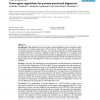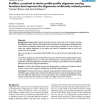258 search results - page 24 / 52 » A Framework for Improving Protein Structure Predictions by T... |
BMCBI
2007
13 years 8 months ago
2007
Background: Many algorithms exist for protein structural alignment, based on internal protein coordinates or on explicit superposition of the structures. These methods are usually...
BIBM
2008
IEEE
14 years 3 months ago
2008
IEEE
Abstract—The exact relationship between protein active centers and protein functions is unclear even after decades of intensive study. To improve the functional prediction abilit...
BMCBI
2008
13 years 8 months ago
2008
Background: Structural alignment of RNAs is becoming important, since the discovery of functional non-coding RNAs (ncRNAs). Recent studies, mainly based on various approximations ...
BMCBI
2005
13 years 8 months ago
2005
Background: Profile-profile methods have been used for some years now to detect and align homologous proteins. The best such methods use information from the background distributi...
JCB
2006
13 years 8 months ago
2006
Protein fold recognition is an important step towards understanding protein three-dimensional structures and their functions. A conditional graphical model, i.e., segmentation con...


